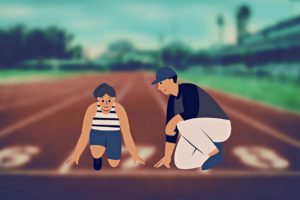If you’ve ever picked up a children’s book, chances are you’ve been drawn in not just by the words on the page, but by the colorful illustrations that bring the story to life. Illustrations play a vital role in children’s books, not only capturing the attention of young readers but also enhancing their understanding of the story.
As a parent or educator, understanding the role of illustrations in children’s books and the art of visual storytelling can help you choose the right books for your child and foster a love of reading.
Visual storytelling is the use of pictures to convey a story or message. In children’s books, illustrations are not merely decorative, but an integral part of the storytelling process. They can depict characters and settings, convey emotion, and provide context for the text.
The use of illustrations can also help children who are still learning to read to understand the story and can provide a visual aid to those who struggle with reading comprehension. By understanding the importance of illustrations in children’s books, you can help your child develop a love of reading and appreciation for the art of visual storytelling.
Key Takeaways
- Illustrations are crucial in children’s books, as they visually tell the story and help captivate young readers.
- Illustrations play a vital role in the cognitive development of children, helping them learn new vocabulary, understand different concepts, and develop their imagination.
- Collaborating with an illustrator is key to creating a successful children’s book, and finding someone whose style complements the story and vision for the book is crucial.
- Illustrations are not merely decorative, but an integral part of the storytelling process, and can enhance the reading experience for children by helping them understand and relate to the characters.
The Importance of Illustrations in Children’s Books
Illustrations are crucial in children’s books, as they help to visually tell the story and captivate young readers. Children’s books are not just about the story, but also about the experience of reading.
The emotional impact of illustrations is a powerful tool in helping children connect with the story and learn important life lessons. The colors, textures, and shapes in illustrations can help children understand and relate to the characters, making the story come alive in their minds.
In addition to the emotional impact, illustrations also play a vital role in the cognitive development of children. By looking at the pictures, children can learn new vocabulary, understand different concepts, and develop their imagination. Illustrations can also help children learn about different cultures, lifestyles, and traditions.
Overall, illustrations are an essential part of children’s books, helping young readers learn and grow in a fun and engaging way.
The Art of Visual Storytelling
You can truly bring a story to life by using pictures to convey emotions and actions, allowing the reader to feel like they’re a part of the story.
The art of visual storytelling goes beyond just illustrating the words on a page.
A skilled illustrator can use color psychology to evoke certain emotions in the reader, and also ensure cultural representation in the images they create.
With color psychology, an illustrator can use colors to convey certain emotions and moods. For example, warm colors like red and orange can convey excitement or anger, while cool colors like blue and green can convey calmness or sadness.
By using these colors strategically in illustrations, the reader can feel the emotions being conveyed in the story.
Additionally, cultural representation in illustrations is important for children to see themselves reflected in the stories they read.
By ensuring that diverse characters are accurately represented in illustrations, children can see themselves in the stories and feel a sense of pride in their own culture.
Types of Illustrations
Get ready to dive into the world of different types of illustrations that can enhance the reading experience!
There are two main types of illustrations commonly used in children’s books: digital illustrations and hand drawn illustrations.
Digital illustrations are created using software such as Adobe Photoshop or Illustrator. They’re often more polished and can be easily edited or adjusted. Digital illustrations are popular in modern children’s books, as they can be easily reproduced and distributed.
On the other hand, hand drawn illustrations are created by hand using traditional mediums such as pencil, pen, or watercolor. They have a unique charm and can add a personal touch to the book. Hand drawn illustrations are often seen in classic children’s books and can evoke a sense of nostalgia.
Both types of illustrations have their own strengths and can greatly enhance the reading experience.
Choosing the Right Illustrations
When selecting appropriate illustrations, it’s important to consider the intended audience and the tone of the story being told.
The illustration style should match the mood and genre of the book. For example, a picture book aimed at young children may benefit from bright and bold illustrations, while a middle-grade fiction book may require more detailed and realistic drawings.
Audience engagement is also crucial when choosing illustrations. The illustrations should be visually appealing and draw the reader’s attention. They should complement the text and enhance the story, rather than distract from it.
Ultimately, the right illustrations can make or break a children’s book, so taking the time to carefully consider the style and engagement level of the illustrations can significantly impact the success of the book.
Collaborating with Illustrators
Collaborating with an illustrator can be a rewarding experience, as it allows for a unique and creative partnership between the author and artist. However, it’s important to approach the hiring process with care and consideration.
When selecting an illustrator, it’s crucial to find someone whose style complements the story and vision for the book. Look for artists whose portfolio showcases work that resonates with the tone and themes of the manuscript.
Once an illustrator is hired, clear communication is key to ensuring a successful collaboration. Establish communication strategies early on to prevent misunderstandings and ensure that both parties are on the same page. Determine how often you’ll check in with the illustrator, what information needs to be shared, and how feedback will be given.
By maintaining open and honest communication throughout the process, authors and illustrators can work together to create a beautifully illustrated book that captures both the essence of the story and the illustrator’s unique vision.
The Future of Illustrations in Children’s Books
As you explore the world of picture books, you’ll notice that more and more authors are experimenting with innovative techniques and mediums to create captivating illustrations that bring their stories to life.
One trend that’s gaining popularity is digital illustration. With the rise of technology, many illustrators are now using digital tools to create detailed and vibrant illustrations that capture the attention of young readers. This allows for more flexibility and creativity in the design process, as well as the ability to easily make changes and edits.
Another trend that’s emerging is the use of interactive books. These books not only feature stunning illustrations but also incorporate elements of technology to engage young readers in a whole new way. Interactive books may include touchscreens, sound effects, or even augmented reality features that bring the illustrations to life. This provides a new level of immersion and interactivity for children, making reading a more exciting and engaging experience.
As the world continues to evolve, it’s exciting to see how technology and innovation will continue to shape the future of illustrations in children’s books.
Frequently Asked Questions
How do illustrations impact the cognitive development of children?
When it comes to children’s books, illustrations can have a significant impact on their cognitive development. Specifically, illustrations can help to promote empathy development in children.
This is because illustrations can help to visually represent different emotions and experiences, allowing children to better understand and connect with characters in the story.
Additionally, there is a difference between digital and hand-drawn illustrations in children’s books. While digital illustrations may be more visually impressive, hand-drawn illustrations can offer a more authentic and personal touch that may resonate better with young readers.
Overall, illustrations are an important aspect of children’s books that can have a lasting impact on their development.
Can illustrations in children’s books be too simplistic or too complex?
When it comes to illustrations in children’s books, it’s all about balancing creativity between simplistic and complex designs. The importance of age-appropriate illustrations cannot be overstated, as children need visuals that match their comprehension levels.
Too simplistic illustrations may insult their intelligence, while too complex ones may confuse them. It’s crucial to strike a balance that aligns with the cognitive development of children. As such, illustrators must be careful with their designs and ensure that they cater to the target audience.
A good illustration is not just about being visually appealing; it’s also about conveying the story’s message effectively. Therefore, it’s essential to strike a balance between creativity and age-appropriateness when creating illustrations for children’s books.
What is the process for creating illustrations in a children’s book from start to finish?
When creating illustrations for a children’s book, the collaboration process between the author and illustrator is crucial in bringing the story to life.
The first step is typically brainstorming and sketching out ideas. From there, the illustrator can choose to create the illustrations digitally or through traditional mediums such as paint or pencil. Digital illustrations offer more flexibility and can be easier to edit, while traditional illustrations provide a unique texture and feel.
Once the illustrations are completed, they are often reviewed and revised before being incorporated into the final version of the book. It’s important to strike a balance between the illustrations and the text, ensuring that they complement each other and tell the story in a cohesive way.
How do cultural considerations affect the choice of illustrations in children’s books?
When choosing illustrations for children’s books, it’s important to consider cultural sensitivity and artistic styles.
Different cultures have unique perspectives on what images are appropriate for children and what messages they convey. An illustration that may be acceptable in one culture may be offensive or confusing in another.
Additionally, artistic styles vary across cultures and can play a significant role in how the story is perceived. For example, a book set in a traditional Japanese setting may benefit from illustrations that incorporate elements of Japanese art and culture.
Ultimately, the choice of illustrations should be made with sensitivity and respect for the intended audience and culture.
Are there any legal or copyright issues to consider when using illustrations in children’s books?
When using illustrations in children’s books, there are some legal considerations to keep in mind. You need to ensure that you have the necessary permissions to use the illustrations, whether they were created by you or someone else. This means that you should be familiar with fair use policies and other copyright laws that apply to your situation.
If you’re not sure about the legal implications of using certain illustrations, it’s best to consult a lawyer or other legal expert. By doing your due diligence and following proper legal procedures, you can use illustrations in your children’s book without worrying about any legal issues down the line.
Conclusion
Congratulations! You now have a better understanding of the role of illustrations in children’s books and the art of visual storytelling.
Illustrations can help children understand complex ideas, evoke emotions, and enhance the reading experience.
When choosing illustrations, it’s important to consider the audience and the story being told. Collaborating with illustrators can also lead to a more cohesive and effective final product.
As technology advances, the future of illustrations in children’s books will continue to evolve and push the boundaries of what’s possible.
Keep exploring and experimenting with illustrations to create magical and unforgettable reading experiences for children.

















